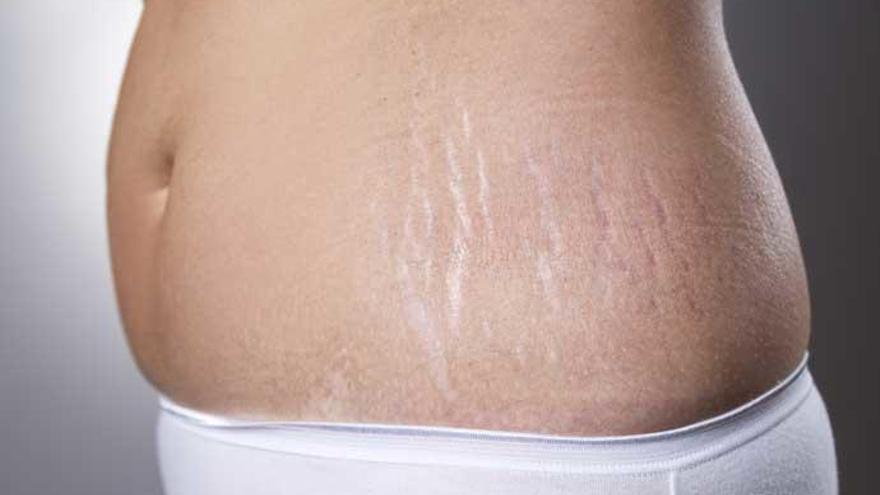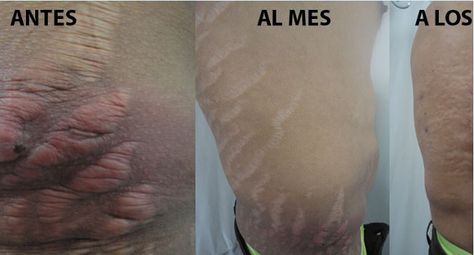Have you ever noticed those distinct lines on your skin, perhaps on your abdomen, thighs, or arms? Often, these are simply referred to as stretch marks. But in some circles, particularly in Spanish-speaking communities, you might hear a more evocative term: "estrias reventadas," which literally translates to "ruptured stretch marks." This term vividly captures the underlying biological process: a literal breaking or tearing of the skin's internal structure. Far from just a surface-level issue, these marks are a testament to the incredible elasticity of our skin being pushed beyond its limits.
While incredibly common, especially among women, pregnant individuals, and adolescents, stretch marks are often misunderstood. This article aims to shed light on what these "ruptured" marks truly are, why they appear, how they evolve, and what steps you can take to prevent them or improve their appearance. Let's delve into the fascinating, albeit sometimes frustrating, world of stretch marks.
What Exactly Are Stretch Marks? The "Rupture" Explained
Medically known as striae or striae distensae, stretch marks are a type of scar that forms on the skin. The term "ruptured" in "estrias reventadas" perfectly describes their origin. They are not merely superficial lines; rather, they are visible evidence of an internal breakdown. Our skin is composed of several layers, and within the dermis (the middle layer), there's a crucial network of collagen and elastic fibers. These fibers are responsible for giving our skin its strength, flexibility, and ability to bounce back.
- Ashlee Davis Twitter
- Nikki Brooks Twitter
- Connell Twins Twitter
- Neverwinter Xbox One Twitter
- Maegan Hall Twitter
When the skin stretches rapidly and significantly, these vital fibers can literally tear or rupture. This process leads to the formation of linear scars. Think of it like a piece of fabric being stretched too far, causing the threads to break. The body attempts to repair this internal damage, but the repair process results in a scar that differs in texture and color from the surrounding skin. This is why stretch marks are often described as "scar-like lesions" or "linear scars." They appear when the skin is stretched beyond its normal capacity and lacks sufficient elasticity to adapt to the rapid change.
Why Do These "Ruptures" Happen? Common Causes
The primary trigger for stretch marks is rapid skin stretching. However, several underlying factors can contribute to this accelerated distension and the subsequent rupture of dermal fibers:
- Rapid Weight Changes: Significant and sudden weight gain or loss can put immense strain on the skin, causing the fibers to break.
- Accelerated Growth: Adolescence is a common period for stretch marks, as growth spurts can cause the skin to stretch quickly, especially in areas like the hips, thighs, and breasts.
- Pregnancy: This is perhaps the most well-known cause. As the abdomen, breasts, and hips expand rapidly to accommodate a growing baby, the skin undergoes considerable stretching. Stretch marks are common in pregnant women.
- Hormonal Factors: Certain hormonal fluctuations or conditions can affect skin elasticity. For instance, an increase in the hormone cortisol can weaken elastic fibers. If a healthcare provider suspects an elevated cortisol level, they might recommend additional tests.
- Genetics: While not a direct cause, genetics can play a role in an individual's predisposition to developing stretch marks. If your parents have them, you might be more likely to develop them too.
- Medications: Prolonged use of corticosteroid creams or oral corticosteroids can decrease collagen production and skin elasticity, making stretch marks more likely.
It's worth noting that stretch marks are predominantly observed in women, though men can certainly develop them as well.
Where Do "Ruptured" Stretch Marks Appear? Common Locations
Because they are caused by stretching, "ruptured" stretch marks tend to appear in areas of the body that undergo significant changes in size or shape. These commonly include:
- The abdomen (especially during pregnancy)
- Breasts
- Hips
- Buttocks
- Thighs
- Upper arms
- Lower back
They often appear in places where fat tends to accumulate or where rapid growth occurs.
The Evolution of a "Rupture": Different Types of Stretch Marks
Stretch marks aren't static; they evolve over time, and their appearance changes depending on their stage of development. Understanding these stages is crucial because it can influence the effectiveness of various treatments.
Early Stage: Red and Purple Marks
When stretch marks first form, they are often described as "lines of a reddish-violet or pinkish color." These are the newer, more active "ruptures." At this stage, there's still inflammation and blood flow to the affected area, which gives them their distinct color. They might also feel slightly raised or itchy. Because they are still relatively new and the skin is actively trying to repair itself, these red or purple stretch marks (medically known as striae rubrae) are generally more responsive to treatment.
Later Stage: White and Scarred Marks
Over time, as the inflammation subsides and the healing process completes, the stretch marks mature. They lose their reddish hue and typically fade to a whitish, silvery, or off-white color. These are known as white stretch marks (striae albae). At this stage, they are fully formed scars, and the blood vessels that initially gave them color have narrowed. They might also appear slightly depressed or sunken compared to the surrounding skin. While more challenging to treat than their red counterparts, improvements in their appearance are still possible.
Diagnosing Stretch Marks: When to See a Doctor
For most people, stretch marks do not require a formal diagnosis from a healthcare provider. Their appearance is usually distinctive enough. However, if you are concerned about their presence, their sudden appearance without an obvious cause, or if they are accompanied by other symptoms, it's always a good idea to consult a doctor.
A healthcare provider will likely examine your skin and review your medical history. As mentioned earlier, if they suspect an underlying condition, such as an increase in cortisol levels (which can be a sign of certain endocrine disorders), they might recommend additional tests to rule out or confirm such possibilities. Otherwise, the consultation will likely focus on management and cosmetic improvement.
Preventing the "Rupture": Daily Strategies
While it's not always possible to completely prevent stretch marks, especially during periods like pregnancy or rapid growth, there are proactive steps you can take to reduce their likelihood and severity:
- Maintain a Healthy Weight: Avoiding rapid and drastic weight fluctuations is one of the best ways to prevent stretch marks. Gradual weight changes give your skin more time to adapt.
- Keep Your Skin Hydrated: Well-hydrated skin is more elastic and resilient. Regularly moisturizing your skin, especially in areas prone to stretching, can help maintain its suppleness. Look for lotions and creams rich in ingredients like shea butter, cocoa butter, hyaluronic acid, and vitamin E.
- Nutrient-Rich Diet: A diet rich in vitamins (especially C and E), zinc, and silica supports healthy skin and collagen production.
- Stay Hydrated Internally: Drinking plenty of water helps keep your skin supple and elastic from within.
Healing and Improving the Appearance of "Ruptured" Stretch Marks
While stretch marks are permanent scars, their appearance can often be significantly improved. The effectiveness of treatments can vary depending on the age and type of the stretch mark (red vs. white) and individual skin response.
Home Remedies and Skincare
For those looking for at-home approaches, consistency is key:
- Exfoliation: Regular, gentle exfoliation can help remove dead skin cells and encourage new cell turnover, potentially improving the texture of the marks.
- Intense Hydration: Continuously moisturizing the affected areas with rich creams and oils can help. For white (already scarred) stretch marks, products containing specific active ingredients can be beneficial. These include:
- Retinoids (e.g., Tretinoin): These derivatives of Vitamin A can stimulate collagen production and are often effective for newer, red stretch marks. They should be used with caution and under professional guidance, especially during pregnancy.
- Hydroxy Acids (e.g., Glycolic Acid): These can help exfoliate the skin and promote cell renewal.
- Centella Asiatica: An herbal extract known for its wound-healing and collagen-stimulating properties.
Professional Treatments
For more noticeable or stubborn stretch marks, various aesthetic treatments offered by dermatologists or licensed professionals can provide more significant results:
- Laser Therapy: Different types of lasers are used. Pulsed dye lasers are often effective for newer, red stretch marks by targeting blood vessels. Fractional lasers (like Fraxel) create microscopic injuries to stimulate collagen and elastin production, improving the appearance of both red and white marks.
- Dermaroller/Microneedling: This procedure involves using a device with fine needles to create tiny punctures in the skin, which stimulates the body's natural healing process and collagen production.
- Chemical Peels: Can help to improve skin texture and color by removing outer layers of skin.
- Microdermabrasion: A less invasive exfoliation technique that can improve superficial marks.
It's important to consult with a skincare professional to determine the best treatment option for your specific type of stretch marks and skin. Each type of stretch mark, depending on its stage and characteristics, reacts better to certain treatments.
Final Thoughts
The term "estrias reventadas" or "ruptured stretch marks" is a powerful reminder that these common skin marks are not just superficial lines but a result of the dynamic and sometimes challenging processes our bodies undergo. From rapid growth to pregnancy and weight changes, our skin is constantly adapting. While they are a natural part of life for many, understanding their causes and evolution empowers us to take proactive steps for prevention and to explore effective options for improving their appearance.
Whether you embrace them as a testament to life's journey or seek to minimize their visibility, remember that healthy, hydrated skin is always a beautiful foundation. Consult with healthcare professionals for personalized advice and to explore the most suitable treatments for your individual needs.
Related Resources:



Detail Author:
- Name : Macy Renner
- Username : monahan.abraham
- Email : luettgen.gust@beer.com
- Birthdate : 1970-10-13
- Address : 2326 Botsford Island South Raymundohaven, PA 59607
- Phone : (660) 499-2547
- Company : Kuhlman-Gottlieb
- Job : Occupational Therapist Assistant
- Bio : Neque necessitatibus nam minus aperiam. Consequatur iure corrupti qui delectus voluptas sunt illo.
Socials
facebook:
- url : https://facebook.com/pacocha2005
- username : pacocha2005
- bio : Impedit provident molestiae eum qui repudiandae corrupti tempore.
- followers : 4984
- following : 608
instagram:
- url : https://instagram.com/pacocha1973
- username : pacocha1973
- bio : Eligendi dolor molestias quo provident. Est temporibus aut modi dolores. Natus aut iure cum sunt.
- followers : 2020
- following : 1103
linkedin:
- url : https://linkedin.com/in/pacocha2009
- username : pacocha2009
- bio : Nostrum debitis dolorem vero minus veritatis.
- followers : 3152
- following : 1537
tiktok:
- url : https://tiktok.com/@pinkie.pacocha
- username : pinkie.pacocha
- bio : Rem et maiores aut officiis illum magni.
- followers : 3995
- following : 2433